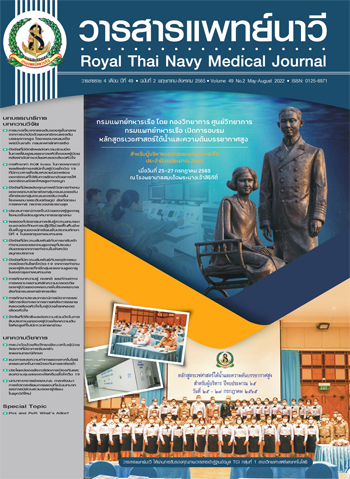The Role of a Nurse Teacher: The Development of Active Learning of Teaching and Learning in a New Normal
Main Article Content
Abstract
Teaching and learning through active learning is a new concept that is popular in the late 21st century. It is a learning process based on the concept of intellectual creativity (constructionism) to focus on the process of self-learning rather than just listening to the course content. The teaching method emphasizes on the participation of learners under the supervision of an instructor as a guide. This method will be effective to encourage or facilitate learners to learn through the process of advanced thinking, analysis, synthesis and evaluation of learning behaviors through practice, teaching and learning.
The new normal brought about by Coronavirus Disease (Covid-19) has caused changed and affected the school management. It requires a change in the learning model of the nursing profession which prohibit students to practice with real patients in the ward. This has led to a change in teaching and learning management style according to the appropriateness of “New Life” (New normal). Development of active learning management which focuses on the student consists of 4 steps: 1) Instructional design, 2) Instructional activity design, 3) Learning and teaching activities, and 4) Measurement and evaluation of teaching and learning management. All of steps are leading to learning outcomes that make learners happy, provide study skills as required by the curriculum and to have desirable graduate qualities in the 21st century.
Article Details

This work is licensed under a Creative Commons Attribution-NonCommercial-NoDerivatives 4.0 International License.
References
Ministry of Education. National Education Act B.E. 2542 (1999) and Amendments (No. 2) B.E. 2545 (2002) with relevant ministerial regulations and the Compulsory Education Act B.E. 2545 (2002). Bangkok: Delivery & Parcel Organization; 2003. (in Thai).
Bonwell CC, Eison JA. Active learning; creating excitement in the classroom. ASHE-ERIC higher education report. Washington DC: The George Washington University, School of Education and Human Development; 1991.
Felder RM, Brent R. Navigating the bumpy road to student-centered instruction. College Teaching 1996;44(2):43-7.
Pruttikul S. Educational administration for change in 21st century. Journal of Education 2017;28(2):36-49. (in Thai).
Silberman ML. Active learning: 101 strategies to teach any subject. New Jersey: Prentice-Hall; 1996.
Cornell University. Center for teaching innovation. [Internet]. [cited 2022 April 25]. Available from: http://www.cte.cornell.edu.
Ruangsuwan C. Educational technology. Bangkok: O.S. Printing House; 2010. (in Thai).
Dale E. Audio-visual methods in teaching. 3rd ed. New York: Dryden Press; 1969. p. 108.
McKinney SE, Haberman M, Stafford-Johnson D, Robinson J. Developing teachers for high-poverty schools: the role of the internship experience. Urban Education 2008;43(1): 68-82.
Funfuengfu V. The success of active learning management. Valaya Alongkorn Review 2019;9(1):135-45. (in Thai).
Yolao D. A study of PBL-based learning management derived from the knowledge-building project to enhance 21st century skills of children and youth: from the success experiences of Thai schools. Bangkok: Thiphayawisut Publisher; 2014. (in Thai).
Ministry of Education. Basic education core curriculum 2008. 2nd ed. Bangkok: Agricultural Cooperative Association of Thailand; 2010. (in Thai).

